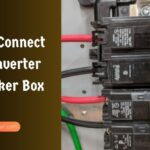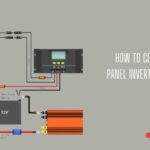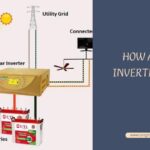How Does a Solar Inverter Synchronize With Grid?
How Does a Solar Inverter Synchronize With Grid? by detecting the grid’s frequency and voltage. Harnessing solar energy has become increasingly popular in recent years as people look for sustainable and environmentally friendly sources of power.
One essential component of solar power systems is the solar inverter, which is responsible for converting the direct current (DC) generated by solar panels into the alternating current (AC) that is used in most household appliances. In addition to this crucial function, solar inverters also play a crucial role in ensuring that the solar power system remains synchronized with the local electrical grid.
This synchronization is essential to ensure efficient power transfer and to prevent potential problems such as power outages or damage to the solar system. We will explore how a solar inverter synchronizes with the grid to ensure optimal performance and safety.
How Solar Inverters Enable Efficient Power Conversion
When it comes to harnessing the power of solar energy, solar inverters play a crucial role in enabling efficient power conversion. Solar panels absorb sunlight and convert it into direct current (DC) electricity. However, most homes and businesses use alternating-current (AC) electricity. This is where solar inverters come into play. They are the key components that convert the DC electricity generated by the solar panels into AC electricity that can be used by appliances and fed back into the grid.
How to Connect Solar Panel Inverter And Battery
Role Of Solar Inverters In Capturing And Converting Solar Energy
Solar inverters perform multiple functions to ensure the efficient conversion of solar energy. Let’s take a closer look at their key roles:
- DC to AC conversion: The primary function of a solar inverter is to convert the DC electricity produced by solar panels into AC electricity. This conversion makes the energy compatible with standard electrical systems used in homes and businesses.
- Maximum power point tracking (MPPT): Solar inverters are equipped with MPPT technology, which optimizes the efficiency of solar panels. MPPT allows the inverter to automatically adjust the voltage and current output of the solar panels to maximize the power generated under changing sun conditions.
- Synchronization with the grid: Solar inverters synchronize the AC electricity generated by the solar panels with the power grid. This ensures that the electricity generated is in phase with the grid’s AC power, allowing seamless integration and distribution of solar energy.
- Grid protection: Solar inverters also provide vital protection mechanisms to prevent unforeseen events, such as overvoltage or under-frequency conditions, from affecting the integrity of the grid. They continuously monitor the grid parameters and disconnect from the grid if necessary to safeguard the system and prevent damage.
Types Of Solar Inverters And Their Functionalities
There are several types of solar inverters available, each with its own specific functionalities. Let’s explore some of the commonly used types:
| Type | Functionality |
| String inverters | Convert the DC electricity from multiple solar panels connected in series into AC electricity. They are cost-effective and widely used in residential and small commercial installations. |
| Microinverters | Installed on each solar panel, they convert DC to AC electricity individually. Microinverters allow for panel-level monitoring, enhanced performance, and increased flexibility in system design. |
| Central inverters | Typically used in large-scale solar installations, central inverters convert the collective DC electricity from all the solar panels in the system into AC electricity. They offer high efficiency and are suitable for utility-scale solar projects. |
| Hybrid inverters | These inverters have the capability to manage both solar energy and energy storage systems, such as batteries. They enable the utilization of stored energy during times of low solar generation or grid outages. |
By using the appropriate type of solar inverter for a specific application, efficient power conversion and seamless integration with the electrical grid can be achieved.
Grid Synchronization: The Key To Reliable Solar Power Integration
Importance Of Grid Synchronization In Maximizing Power Efficiency
The synchronization of a solar inverter with the grid is essential to ensuring reliable and efficient integration of solar power. By synchronizing the solar inverter with the grid, it becomes possible to match the frequency and voltage levels of the solar power system to those of the utility grid.
Why is this important?
- Optimal Power Generation: Synchronization allows solar inverters to generate electricity at the same frequency and voltage as the grid. This ensures that the maximum amount of solar power is fed into the grid, enabling efficient utilization of the available solar resources.
- Grid Stability: Synchronization helps maintain the stability of the grid by ensuring that the solar power system does not introduce any voltage or frequency fluctuations that could destabilize the grid. By synchronizing with the grid, the solar inverter becomes a reliable source of electricity without compromising grid reliability.
- Increasing Renewable Energy Penetration: Grid synchronization enables higher penetration of renewable energy sources, such as solar power, into the grid. It allows solar power systems to function in parallel with the utility grid, contributing to the overall reduction of greenhouse gas emissions and dependence on fossil fuels.
- Enhancing Energy Efficiency: Synchronization helps optimize energy efficiency by enabling solar inverters to operate at their highest efficiency levels. This ensures that the solar power generated is effectively utilized, minimizing losses and maximizing the overall energy output.
Challenges And Benefits Of Integrating Solar Inverters With The Grid
Challenges:
- Grid Compatibility: Integrating solar inverters with the grid requires ensuring their compatibility with the grid’s voltage and frequency standards. Any mismatch or non-compliance can lead to operational issues and impact the performance of both the solar power system and the grid.
- Grid Stability: The intermittent nature of solar power can pose challenges to grid stability. While synchronization helps mitigate this, fluctuations in solar power generation due to weather conditions and other factors can affect grid stability. Advanced control mechanisms and grid management techniques are essential to effectively address these challenges.
- Power Quality: Integrating solar inverters with the grid requires ensuring the quality of power injected into the grid. Issues such as harmonics, voltage fluctuations, and improper power factors can arise during integration, affecting the overall power quality of the grid. Implementing appropriate power conditioning measures and monitoring systems is vital to maintaining power quality standards.
Benefits:
- Reduced Reliance on Traditional Power Sources: Integrating solar inverters with the grid facilitates the integration of renewable energy, reducing the dependence on conventional power sources. This contributes to a cleaner and more sustainable energy mix.
- Lower Energy Costs: Solar power integration enables consumers to generate their own electricity, reducing their reliance on the grid and helping lower energy costs in the long term.
- Environmental Sustainability: Solar power integration plays a crucial role in reducing carbon emissions and promoting environmental sustainability. By harnessing the power of the sun, solar inverters contribute to global efforts towards a greener and more sustainable future.
Voltage And Frequency Matching: Achieving Grid Compatibility
Role Of Voltage And Frequency Matching In Grid Synchronization
A solar inverter plays a crucial role in converting the direct current (DC) from solar panels into alternating current (AC) that can be used to power our homes and businesses. However, simply converting the DC power to AC is not enough. In order for the solar energy system to seamlessly integrate with the main electrical grid, it is essential that the voltage and frequency of the inverter’s output match those of the grid.
When solar energy is generated, it flows into the inverter, which converts the DC electricity into AC electricity. The voltage and frequency of the inverter’s output need to be synchronized with the grid’s voltage and frequency to avoid any disruptions or imbalances in the electrical supply. Without proper synchronization, the solar power system would not be able to export excess electricity to the grid, leading to inefficiencies and even potential damage to the equipment.
Techniques Used To Ensure Voltage And Frequency Compatibility
Ensuring voltage and frequency compatibility between the Does a Solar Inverter Synchronize With Grid and the grid requires sophisticated control systems and communication protocols. The following techniques are commonly employed:
- Phase-Locked Loop (PLL): This technique ensures that the inverter’s output voltage and frequency closely track those of the grid. The PLL continuously monitors the grid’s voltage and frequency and adjusts the inverter’s output accordingly, minimizing any deviations.
- Grid Synchronization Algorithms: These algorithms are implemented in the control software of the solar inverter and are designed to detect and synchronize with the grid’s voltage and frequency. They employ advanced mathematical algorithms to calculate and adjust the inverter’s output to match that of the grid.
- Communication Protocols: To achieve grid compatibility, solar inverters often rely on communication protocols such as Modbus or DNP3 to exchange information with the grid. These protocols enable real-time monitoring of the grid’s voltage and frequency, allowing the inverter to adjust its settings accordingly.
| Technique | Description |
| Phase-Locked Loop (PLL) | Continuous monitoring and adjustment of the inverter’s output to closely track the grid’s voltage and frequency. |
| Grid Synchronization Algorithms | Control software algorithms that detect and synchronize with the grid’s voltage and frequency. |
| Communication Protocols | Protocols such as Modbus or DNP3 enable real-time monitoring and adjustment based on the grid’s voltage and frequency. |
By implementing these techniques, solar inverters ensure that the electricity generated from solar panels seamlessly integrates with the main electrical grid. The synchronized voltage and frequency allow for efficient power transfer, reducing wastage and enabling a more reliable and stable electrical supply.
Phase Locking: Aligning Solar Inverter Output With The Grid
Understanding The Concept Of Phase Locking In Grid Synchronization
Phase locking is a fundamental process that allows solar inverters to synchronize their output with the electrical grid. In order to inject clean and reliable solar power into the grid, it is crucial for the inverter’s voltage and frequency to be aligned with that of the grid. This alignment ensures both efficient energy transfer and a stable power supply to households and businesses.
Strategies Used To Achieve Phase Synchronization Between Solar Inverters And The Grid
Utilizing phase-locked loops (PLL)
One of the most common strategies employed to achieve phase synchronization is the use of phase-locked loops (PLL). In this method, the inverter measures the phase difference between its own output and the grid’s voltage and then adjusts its internal clock to synchronize with the grid’s frequency. By continuously monitoring this phase difference and adjusting accordingly, the inverter ensures tightly locked synchronization with the grid.
Frequency detection and synchronization
In addition to phase locking, a solar inverter synchronize With grid and also employs techniques to detect and synchronize its frequency with that of the grid. By continuously monitoring the grid frequency, the inverter can adjust its output frequency accordingly, allowing seamless integration with the grid. Precise frequency synchronization is essential for smooth energy transfer and to maintain the stability of the entire electrical system.
Grid voltage monitoring and synchronization
Furthermore, solar inverters also incorporate mechanisms to monitor and synchronize their voltage with that of the grid. By measuring the grid voltage and comparing it to their internal voltage reference, inverters can ensure that their output voltage matches the grid’s voltage, allowing for a seamless transfer of power. This synchronization is critical to prevent any potential voltage instabilities or disruptions in the grid.
Reactance-based synchronization methods
Another strategy employed by solar inverters is reactance-based a solar inverter synchronize With grid. By analyzing the reactive power flow between the inverter and the grid, inverters can adjust their output impedance to match the grid’s reactance. This method ensures smooth power transfer, minimizes losses, and optimizes the overall efficiency of the solar energy system.
Active power control for synchronization
Active power control is a technique used by solar inverters to synchronize their power output with the grid’s requirements. By dynamically adjusting their active power generation based on grid conditions, inverters can maintain a stable power flow and prevent any imbalances or disruptions. This control mechanism enables efficient utilization of renewable energy while ensuring grid stability.
By using a combination of these strategies, solar inverters can achieve an accurate and synchronized connection with the electrical grid.
Mppt Tracking: Optimizing Solar Power Generation
Exploring Maximum Power Point Tracking (mppt) Technology
Solar panels generate DC (direct current) electricity, whereas the grid operates on AC (alternating current). The solar inverter plays a crucial role in converting the DC electricity from solar panels into AC electricity suitable for grid integration. It ensures that solar power generation aligns with the requirements of the grid and maximizes the efficiency of energy conversion.
When it comes to MPPT technology, it functions as the brain of the solar inverter. It continuously tracks and monitors the varying voltage and current characteristics of the solar panels. By calculating the optimal operating point, also known as the Maximum Power Point (MPP), the MPPT enables the solar inverter to draw the maximum amount of power from the solar panels under varying weather conditions.
Utilizing a sophisticated algorithm, MPPT adjusts the inverter’s operating parameters, such as voltage and current, to ensure optimal power extraction. It dynamically adapts to changes in solar irradiance and temperature, extracting the highest possible power output from the solar panels at any given moment. This allows for efficient energy conversion and maximum utilization of the available solar energy.
Benefits Of Mppt In Capturing And Utilizing Solar Energy Effectively
| Benefits of MPPT Technology |
| Increased Energy Yield |
| Enhanced Efficiency |
| Optimal Utilization of Solar Panels |
| Adaptability to Varying Environmental Conditions |
MPPT technology offers a wide range of benefits that contribute to the optimization of solar power generation. Let’s delve into these advantages:
- Increased Energy Yield: MPPT technology ensures that the solar panels operate at their maximum power output, leading to increased energy yield. By tracking and adapting to the MPP, MPPT enables the solar inverter to generate as much power as possible, even during less favorable weather conditions.
- Enhanced Efficiency: The continuous adjustment of the solar inverter’s operating parameters through MPPT technology leads to improved efficiency in energy conversion. This means that a higher percentage of the generated solar power is effectively utilized and fed into the grid.
- Optimal Utilization of Solar Panels: MPPT helps in optimizing the utilization of solar panels by drawing maximum power output from them. This ensures that the investment made in the solar panel system is fully utilized, allowing for the generation of more electricity.
- Adaptability to Varying Environmental Conditions: Solar energy generation is subject to fluctuations in solar irradiance and temperature. MPPT technology allows the solar inverter to adapt to these changing environmental conditions and maintain optimal power extraction. This ensures a consistent and reliable power supply from the solar panel system.
Reactive Power Compensation: Balancing Grid Demands
The significance of reactive power compensation for power system stability cannot be overstated. Reactive power, although it does not produce useful work, is essential for maintaining voltage levels and ensuring the smooth operation of the electrical grid. Without proper reactive power compensation, the grid can experience voltage fluctuations, increased losses, and compromised power quality.
Significance Of Reactive Power Compensation In Power System Stability
Reactive power compensation plays a crucial role in maintaining the stability of the power system. It helps to balance reactive power demand and supply, ensuring that voltage levels remain within acceptable limits. Reactive power compensation also helps to reduce line losses and enhance power efficiency.
One of the primary challenges to power system stability is reactive power imbalance. Unequal distribution of reactive power within the grid can lead to a variety of issues, including reduced voltage quality, increased transformer heating, and impaired equipment performance. By compensating for reactive power, solar inverters ensure that the reactive power demand is met, enabling the grid to function optimally.
How Solar Inverters Manage Reactive Power Flow And Ensure Grid Stability
Solar inverters play a vital role in managing reactive power flow and maintaining grid stability. They are equipped with advanced control systems that monitor and regulate reactive power exchanges with the grid.
When a solar inverter is connected to the grid, it measures the grid voltage and frequency to determine the reactive power requirements. By continuously monitoring these parameters, the inverter adjusts its output to supply or absorb reactive power as needed.
To compensate for reactive power imbalances, solar inverters utilize various control strategies. One of the common methods is known as reactive power control, where the inverter actively injects or absorbs reactive power into the grid to maintain voltage stability. This control mechanism ensures that the grid’s reactive power demand is met, reducing the risk of voltage fluctuations and other stability issues.
Solar inverters also employ techniques such as power factor correction to improve the overall power quality of the grid. Power factor correction involves adjusting the phase relationship between voltage and current, resulting in a power factor closer to unity. This not only minimizes reactive power flow but also reduces losses in the transmission and distribution system.
In conclusion, reactive power compensation is crucial for maintaining the stability and reliability of the electrical grid. Solar inverters play a significant role in managing reactive power flow and ensuring grid stability, employing control strategies to balance reactive power demands. By effectively compensating for reactive power, solar inverters contribute to optimal power system performance, reduced losses, and enhanced power quality.
Anti-islanding Protection: Preventing Grid Instability
Understanding The Importance Of Anti-islanding Protection
Anti-islanding protection is a crucial feature that ensures the stability and safety of the grid when solar inverters are connected. Islanding refers to the situation when a solar PV system continues to operate independently, producing and feeding electricity into the grid, even when the grid power supply is shut off. This can lead to grid instability, potential damage to electrical equipment, and safety hazards for utility workers.
Techniques Used To Detect Islanding Conditions And Ensure Grid Safety
Various techniques are employed to detect islanding conditions and prevent grid instability. These techniques involve rapid monitoring and quick response from the solar inverter, ensuring the grid remains stable and secure. Let’s take a closer look at some of these techniques:
1. Frequency-watt anti-islanding protection:
This technique works by continuously monitoring the grid frequency. In the presence of a stable grid, the frequency remains within a specific range. However, if an islanding condition occurs, the frequency may start to deviate. Because it has a frequency-watt anti-islanding protection feature, the Does a Solar Inverter Synchronize With Grid is set up to notice these changes and either lower or turn off the power output right away. This helps prevent the islanding situation and protects the grid from instability.
2. Voltage-watt anti-islanding protection:
Similar to the frequency-watt technique, the voltage-watt anti-islanding protection method continuously monitors the grid voltage levels. If an islanding condition is detected, the grid voltage might fluctuate outside the normal range. In such cases, the solar inverter equipped with this protection feature adjusts the power output accordingly to prevent islanding and ensure grid safety.
Fault Detection and Ride-through Capability: Maintaining Grid Reliability
Role Of Fault Detection And Ride-through Capability In Grid Stability
One of the key factors in maintaining grid reliability is the fault detection and ride-through capability of a solar inverter synchronize With grid. The task of converting the direct current that solar panels produce into alternating current for grid feeding falls on solar inverters. However, grid instability can occur due to various reasons, such as grid faults, voltage fluctuations, or sudden changes in load. In such situations, the fault detection and ride-through capability of solar inverters play a crucial role in ensuring uninterrupted power supply and maintaining the stability of the grid.
Measures Implemented By Solar Inverters To Detect And Ride Through Grid Faults
Solar inverters are equipped with advanced technologies and algorithms to detect and ride through grid faults. These measures are designed to quickly identify any abnormalities in the grid and respond accordingly, thus preventing any disruption to the power supply. Here are some key measures implemented by solar inverters:
Power Quality Monitoring:
Solar inverters constantly monitor the quality of power being fed into the grid. They measure parameters such as voltage, frequency, and waveform distortion to ensure that the power supplied meets the required standards. The inverter detects and responds to any variations or deviations from the norm, maintaining the grid’s stability.
Grid Code Compliance:
Solar inverters are designed to comply with grid codes, which define the technical requirements and guidelines for connecting renewable energy systems to the grid. These codes specify the necessary functions, capabilities, and performance criteria that solar inverters must adhere to. By complying with grid code regulations, solar inverters ensure that they can effectively detect and respond to grid faults, contributing to the overall stability of the grid.
Fast Fault Detection:
Solar inverters employ fast fault detection algorithms that can quickly identify grid faults. These algorithms continuously monitor the grid for abnormal conditions, such as voltage sags or voltage swells.
Ride-through Capability:
For solar inverters to be able to detect faults and continue working during temporary fault conditions, they also have ride-through features that let them handle grid disturbances. This capability allows the inverter to ride through momentary grid fluctuations, such as voltage dips or interruptions, and maintain power generation. By doing so, solar inverters help stabilize the grid by preserving the continuity of the power supply.
Voltage and Frequency Control:
Does a Solar Inverter Synchronize With Grid also play a role in maintaining voltage and frequency stability on the grid. They are equipped with voltage and frequency control mechanisms that actively regulate power output based on grid conditions. In conclusion, the fault detection and ride-through capability of solar inverters are vital for maintaining grid reliability.
FAQs: How Does A Solar Inverter Synchronize With Grid
How Do You Sync Solar Power With A Grid?
Syncing solar power with a grid involves using an inverter to convert the DC power from solar panels into AC power, which is compatible with the electrical grid. The inverter regulates the voltage and frequency so that it matches the power from the utility grid, allowing seamless integration and two-way power flows.
How Does Grid-Tie Inverter Synchronization
Grid-tie inverter synchronization is achieved by matching the frequency and phase of the inverter’s output with the utility grid. This ensures that the electricity generated by the inverter is synchronized and compatible with the grid, allowing for seamless energy transfer.
How Does An Inverter Match Grid Frequency?
The inverter matches grid frequency by adjusting the output frequency of electricity to synchronize with the frequency of the power grid. This ensures that the electricity generated by the inverter is compatible and can be seamlessly injected into the grid.
Does A Hybrid Inverter Synchronize With The Grid?
Yes, a solar inverter synchronize With grid. It efficiently converts solar energy into electricity and is capable of supplying power to the grid as well as storing excess energy for later use. The inverter seamlessly switches between grid power and stored energy based on demand.
Conclusion
The synchronization of a solar inverter with the grid is a crucial process in ensuring the seamless flow of electricity. By harmonizing the frequency and voltage levels, the solar inverter facilitates the integration of solar power into the existing electrical grid.
This synchronization enables efficient power transfer, reduces the reliance on fossil fuels, and contributes to a more sustainable energy future. Embracing solar energy and understanding how solar inverters synchronize with the grid can lead to a greener and more environmentally friendly world.




